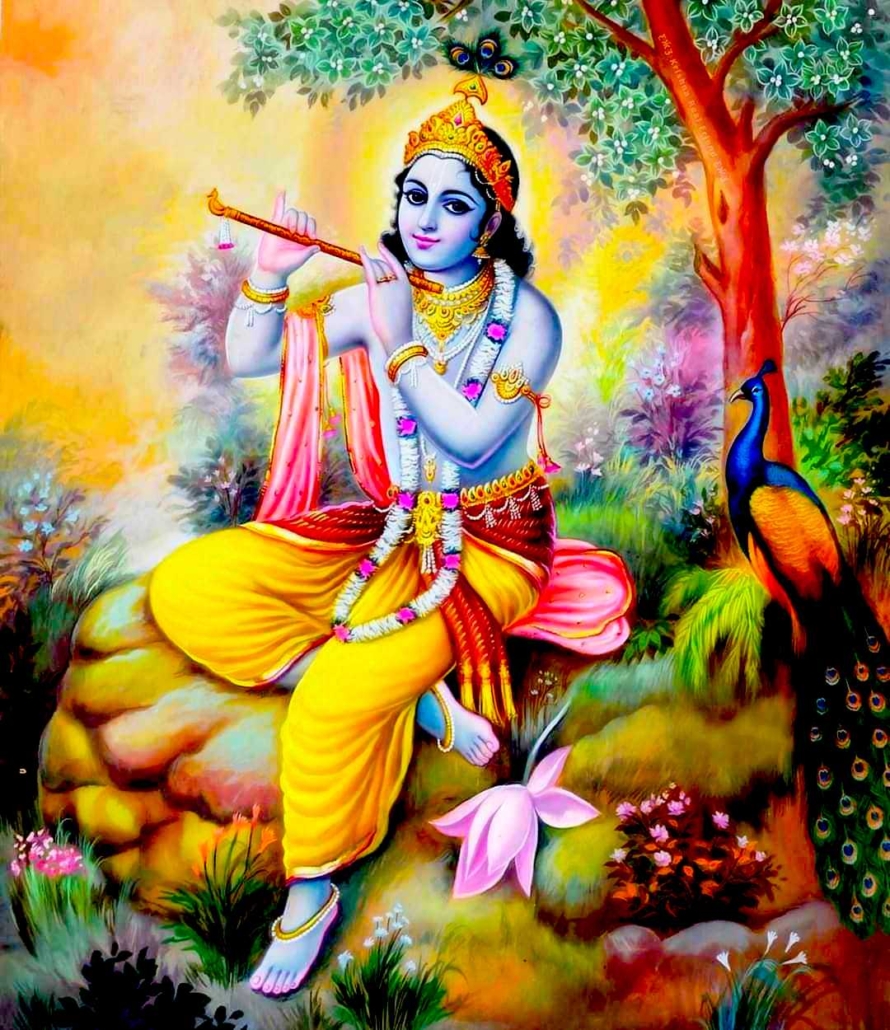Mahanidhi Madan Gopal Das
Herein we present a continuous sweet selection of tikas from the great rasika-acarya, Sri Jiva Goswamipada’s Krishna prema-filled comments on the Venu-gita (Srimas Bhagavatam 10.21). By reading and studying these comments along with the verses of Venu-gita, you will attain a happy feeling in your heart, and renewed enthusiasm to love and serve Radha and Krishna more and more. Jai Jai Sri Radhe!
Srimad Bhagavatam 10.21.11
Translation: The gopis say, “Blessed are all the less intelligent deer because, on hearing the sound of Krishna’s flute, they and their husbands do the best worship by glancing affectionately at Nandanandan, who is gorgeously dressed.”
Sri Jiva Goswamipada tika: Such is the glory of Vrindavan that all the jivas taking shelter there are very dear to Sri Krishna. Now, let us describe the good fortune of the animals in Vrindavan. The does are without discrimination yet as they wander through Vraja they are directly seen by Krishna.
The Vraja-gopis mention Nanda’s name because their minds are bewildered by uncontrollable agitation. They performed Krishna’s worship with glances filled with affection. Love is the greatest treasure in worship. In great astonishment the gopis speak with lamentation. “O! We do not have such good fortune!”
Srimad Bhagavatam 10.21.12
Translation: The gopis say, “When the devatas’ wives flying in vimans with their husbands see Krishna, whose form and qualities fill all women with joy, and when they hear Krishna’s venu-gita, their hearts are agitated by Cupid, and they become so bewildered that the flowers fall out of their hair and the ropes holding up their undergarments loosen.”
Sri Jiva Goswamipada tika: Both the animals on the ground and the devatas flying in the sky have become supremely fortunate by seeing Krishna whose all-attractive form and qualities immediately incite anuraga in all women. The devis hear Krishna’s flute playing a raga drenched in madhurya-rasa.
They came along with their husbands since they didn’t have the adhikari for direct association with Krishna. Just by seeing Shyam the Svargadevis became intensely afflicted with lust for Krishna. Their enchantment was further enhanced by hearing Krishna’s venu-gita. Hearing and seeing were both causes of bewilderment.
This is the anubhava called mottayita which is the appearance of desire in the heart from the arousal of the sthayi-bhava from remembering or hearing about Krishna.
The gopis pine, “We are most unfortunate for not having seen Krishna, the astonishing ocean of all auspiciousness, who bewilders the foolish female deer and the most intelligent wives of devatas. Or, we are most unfortunate for not seeing Krishna as He wanders in the forest, whereas they are fortunate.”
Srimad Bhagavatam 10.21.13
Translation: The gopis say, “Using their upraised ears as cups, the cows drink the nectar of Krishna’s flute-song flowing out of from His mouth. The calves, their mouths full of milk from their mothers’ moist nipples, with tear-filled eyes, stand still as they embrace Krishna within their hearts.
Sri Jiva Goswamipada tika: Other gopis speak three verses to hide their amorous emotions by describing the cows which have maternal affection for Krishna. “Even cows that are famous for not being able to distinguish good from bad, are relishing the sound of Krishna’s flute coming from His moon-like mouth which is endowed with more nectar than billions of nectar-filled moons.
“Krishna is the fullest embodiment of the highest bliss. In astonishment the cows simply stand, stunned, overcome by sattvika-bhava. Govinda indicates the master of the cows. They touch Krishna with affection. Some calves have mouthfuls of their mothers’ milk flowing from their mouths. Other calves are chewing grass.
“They all start crying as they embrace Govinda in their minds. Since their eyes are covered with tears, they can only see Krishna in their minds. We however are most unfortunate since we cannot even see Krishna.”
Srimad Bhagavatam 10.21.14
Translation: “O Amba! In this forest all the birds have risen onto the budding branches of the trees to see Krishna. With closed eyes, like sages, they are simply listening in silence to the sweet vibrations of Krishna flute, and they speak of nothing except Krishna.”
Sri Jiva Goswamipada tika: In astonishment, the gopis say, “O mother!” (amba)
It is the nature of those immersed in prema to make such statements. Since no mother is present, the gopis address their friends in this manner.
The gopis say, “What to speak of the good fortune of the cows protected by Krishna, how can we describe the fortune of these forest birds? Most of the birds are like this, but some like the peacocks are like the greatest devotees because they are dancing in prema, not just sitting in the tress.
“The birds climb on the branches of trees in order that they can see Krishna or so that Krishna can see them. But the buds create obstacles to seeing Krishna, so they listen to Krishna’s venu-gita with half-closed eyes.” This indicates lassitude because of intense prema.
“No words except the words of the flute are sensed by their minds, ears or voice. Thus, they are fortunate.”
The word munayah refers to atmaramas like the Kumaras who have become birds to see Krishna. When they hear the sound of Krishna’s flute which they have never experienced before, that enchanting sound attracts them away from their brahma-samadhi. These sages have surpassed the branches of the Vedas and given up study of the Vedas. Their consciousness of their bodies has disappeared (milita-drsha—closed vision). The have become silent on all topics except Krishna. What else can they deliberate on?
Venu-gita ki jai! Sri Jiva Goswamipada ki jai!
Radha-Govinda Yugala ki jai! Jai Jai Sri Radhe!

